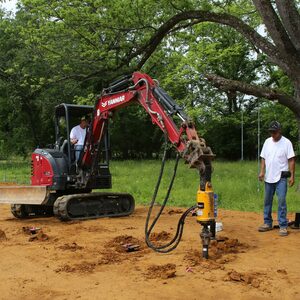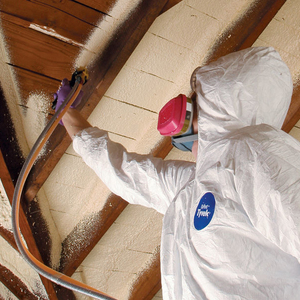DO NOT use canned poly foam (including ‘fireblock’ products) to seal recessed lights or any hot surface

Canned poly foam is very flammable, with an ignition temperature of only ~240 degrees F. This is also true for foam products with “fireblock” or “firestop” on the label, e.g. Great Stuff Fireblock foam, DAP Fireblock foam, 3M Fire Block FB-Foam, etc. sold at Home Depot and Lowes.
Standard and ‘fireblock’ poly foam should never be used to seal a surface that may get hot, e.g. recessed light cans, furnace exhaust ducts, gaps around chimneys — or close to a source of heat, e.g. a furnace or fireplace.
Most contractors and inspectors I have spoken to knew that poly foam is very flammable — but were surprised that ‘fireblock foam’ products ignite at the same temperature. They read the label on the can and trusted that “fireblock” meant what is says.
I hope the manufacturers change course and modify the labels for these products. It would also be helpful to include the ignition temperature of cured foam in sales literature and MSDS spec sheets — some manufacturers only include the ignition temperature of liquid foam when it is applied.
One exception is 3M ‘FIP 1-STEP FIRE RATED FOAM’ — which was released in 2013. This new foam is intumescent with a real “fire barrier” rating. See: www.3m.com/us/bcsd/fire/stop/fip1step/product_details.html
I hope this is helpful.
Mark



















Replies
Mark
Why start another thread when you already have one on the subject?
Maybe "Mark" is a 3M
Maybe "Mark" is a 3M marketing rep and is shooting for a cash bonus by the Martin Luther King Jr. federal holiday.
Mark is a customer -- not a 3M employee
If you read my post you will see that I listed one 3M product to avoid: "3M Fire Block FB-Foam", which is standard poly foam with a low ignition temperature. I also noted the new 3M intumescent foam product, which has a true "fire block" rating: "FIP 1-Step".
Unfortunately, FIP 1-Step is only available via trade distributors like Grainger (or Amazon), and is not being carried by the big retail chains. That's probably because low-end unrated "fireblock" foam products are not permitted for use in commercial and multi-family construction. IRC rules are less stringent for single family homes, so manufacturers are pushing these products into the retail channel.
I've spent the past 30 years as an IT exec, by the way -- remodeling homes on the side. I have no connection to 3M, their competitors or any of the manufacturers, except as a customer.
and your point?
First: Amazon is no more of a "trade distributor" than any big retail chain. In fact, the only difference is that they might be bigger.
Second: What makes your customer message so worthy of a repeat post? Don't you think other end user can read and understand manufacturers specification sheets? Or do you think that you represent some special insight into these products? If you do, then state your credentials and what that might be. Right now, you represent the same weight of authority as any other end user which, on this site, isn't much.
Third: If you think there is some sort of mislabeling or misinformation associated with these products, then why don't you submit your complaint to the FTC.
http://www.ftc.gov/about-ftc
I should think it might have more impact than continually acting as the town crier for this forum.
My point - inform tradespeople and DIY homeowners
Dear Deadnuts:
This was not intended to be a repeat of my general post about flammable poly foam, but rather a focus on using foam to seal recessed light cans -- a mistake I have seen repeatedly in a number of homes. This post was timed to coincide with the excellent article by Larry Armanda in the latest issue of FHB, highlighting the danger created by high temps inside site-built enclosures for recessed light cans.
The problem with reading "manufacturer specification sheets" -- including MSDS documents for these products -- is the surprising lack of information on the ignition temperature of cured foam. Most manufacturers focus only on the characteristics of the liquid when it is applied. I had to contact a DOW tech rep directly, for example, to confirm the ignition temperature of cured Great Stuff foam, including the standard and "Fireblock" versions.
I hope the data I am offering in this forum will clarify these issues for other FHB readers, to avoid more risky installations of these products.
Unfortunately, the FTC cannot intervene in this situation, due to a gap in the 2012 IRC and fuzzy requirements for single family construction. This is compounded by the ICC certification process, where undisclosed manufacturer 'test reports' are accepted for "modified" versions of standard fire safety tests. One manufacturer used concrete panels instead of wood framing for the fire penetration test, for example. Basically, the ICC certification only means "the manufacturer submitted a report"; they do not certify that the foam product actually meets any fire safety standard. Again, the average builder / homeowner would have no way of knowing this unles they spend lots of time researching the details. I hope these posts will help them avoid that.
Mark
Read Larry's article more closely
With respect to Larry Armanda article and your post:
1. The foam Ignition temperature of 240 deg. F that you state in your post was only surpassed in Larry's test box with the use of a 75W A19 light bulb ( only by 6 deg. F) --which are not supposed to be used in just about all recessed can light fixtures. And remember, these temperature are within an insulated enclosure; spray foam around a recess can would not be contained within an enclosure--it is the enclosure. Therefore one side of spray foam would technically be exposed to air flow and be cooler. At any rate, you may say (as he did) that well, some folks do replace with 75W A19 bulbs. Well I guess some folks also try using hair dryers in the bath tub. My point: you can only idiot proof products so much. In my opinion the ignition temp. you state is irrelevant and not an issue worth raising twice --or in conjunction with this article.
2. Regualr 6W PAR 30 produced temperatures up to 192 deg.F in Larry test box. That is below your ignition temp. figure, below NM-B wire rating, and below the thermal safety switch mechanism that is on just about every modern recess lighting rough in on the market. Again, your ignition temp warning does not seem to be an issue. The only potential issue is older NM-B wiring (which Larry provides a solution for). Personally, if your wiring is that old, IMO you shouldn't be using a regular recess fixtures to begin with. If you bought a house that has both, then replace the recess fixtures with surface fixtures (I believe Phillips make a surface mount LED that look just about like a recess or see my next point. Again, foam has nothing to do with it.
3. If nothing else, you can always replace Edison bulb trim kits with new LED trm kits which generated a max. temperatures of 123 deg. F in Larry's test box. You can use NM wiring and all the foam you want to air seal that can without getting anywhere near your ignition temp. It's irrelevant.
The way I see it: Three strikes and your "chicken little" warning is overblown.
Temperature of the recessed can is key -- not the air around it
Dear Deadnuts: If a builder / homeowner sprays poly foam on a recessed light can to seal it, then the temp of the can itself is critical -- not the temperature of the air around it.
Larry did not measure the temperature of the can during his tests. Still, the air in his test enclosure reached 245 degrees with a 75w incandescent bulb. As Larry noted, "Weatherization crews and electricians routinely find the wrong bulb installed in ceiling-mounted light cans..." I often see 100w bulbs.
Poly foam also has a high R value (roughly 5 per inch), so it will contain the heat from the can -- and airflow around the external side of the foam will have minimal impact on the temperature of the foam next to the metal surface of the can. Foam will also insulate the can, reduce the cooling effect of air circulation and raise the temperature further.
If you still have any doubt about the risk, DOW's technical team agrees that Great Stuff should never be used on a recessed light can or other hot surfaces. Larry Armanda also agrees.
Ignore the others...
Ignore the others.
I, for one, apreciate what you are trying to do.
In the spirit of public service and motivated by your informative post, I have also decided to dive into the field of posting construction safety tips.
I'm working on my first piece right now, titled "DANGER! DO NOT FRAME A HOUSE USING 8d FINISHING NAILS!"
Here's my first draft:
DANGER! DO NOT FRAME A HOUSE USING 8d FINISHING NAILS!
Do not frame a house using 8d finishing nails. The nails may not provide proper hold. Even though code restricts using 8d finishing nails in this application and the nail manufacturers do not recommend using them in this manner, someone might do it someday. Don't.
Don't be dismayed by the naysayers. You and I are obviously answering to a higher calling. That higher calling might simply be voices in our heads. But they are not to be ignored.
You might find further inspiration here:
http://www.imdb.com/title/tt1428538/
key to what?
Why would one be concerned about Great Stuff being directly sprayed on a recess can in the first place? IC rated units are made so that they can't come in direct contact with insulation; whether its poly, fiberglass bat, cellulose, etc..
If the recess can is a non IC rated rough-in fixture, then it is not permitted by the manufacturer to be in contact with any insulation material to begin with. If it is IC rated, then that means it generally has a thermal coupling that will cycle the unit off at 194 deg. F. That coupler isn't made to trip regularly because the construction is such that that type of heat built up can't generally happen. For instance, the IC units my electrician usually installes are made by Juno. They have a complete metal box enclosure that keeps the fixture head well seperated (by about 4-6" in all directions) from any possilbe contact with insulation.The thermal coupler monitors the space betwen the fixture head and the metal enclosure. If the wrong bulb is used, then it cuts off at 194 deg. F. Conversley, the non-IC are generally open frame construction where they are specified to be used inside of a home's thermal envelope and not have a reason for spray foam to be used on them in the first place.
Again, I see no reason for DOW or any other manufacturer to idiot proof against one using the wrong bulb or spraying foam directly on a non IC unit. You might see it; but so what? As a remodeler, I see vapor barriers installed on the wrong side of a home's thermal enevelope (mostly in crawl spaces) all the time. This can lead to hazardous mold buildup. Do I feel the need to take Owning Cornings to task to prevent this from ever happening? No.
The key problem: misleading labels and lack of important info
Dear Deadnuts:
I agree: manufacturers can't "idiot proof" their products. The manufacturers of flammable poly foam can eliminate misleading labels, however, and provide important information like the ignition temperature.
When "Fire Block" and "Firestop" are added to the label on the can, builders and homeowners could reasonably assume, "They must have added something to make the foam fireproof." That's exactly what I heard from two building inspectors. Experienced people can be easily misled.
If customers want to double-check the accuracy of these labels, manufacturers often omit key information. For example:
3M: The 2014 MSDS for 3M 'Fire Block Foam FB-Foam' says:
Flammability (solid, gas) Not Applicable
Flammable Limits (LEL) No Data Available
Autoignition temperature No Data Available
Decomposition temperature No Data Available
(A copy is attached)
DOW: The 2013 MSDS for DOW 'Great Stuff Fireblock Foam' says:
Melting point No test data available
Flammability (solid, gas) Flammable gas
Flammable Limits in Air Upper: No test data available
Autoignition Temperature No test data available
Decomposition Temperature No test data available
(A copy is attached.)
DAP: The 2014 MSDS for DAP Fireblock Foam Polyurethane Foam Sealant says:
Flash Point, F: Aerosol
Flammability: Level II Aerosol
Upper Explosive Limit Not Determined
(A copy is attached)
All three MSDS documents focus on the liquid in the can; the only references to "temperature" are about where to store the can. There is nothing about the ignition temperature or flammability of cured foam -- this vital information for customers is missing.
Enough data and documents have been presented to prove the flammability risks behind these products. Hopefully builders and homeowners will read this thread and avoid the problem.
Additional debate will be pointless.
Mark
check your semantics
user-2363665 wrote:
When "Fire Block" and "Firestop" are added to the label on the can, builders and homeowners could reasonably assume, "They must have added something to make the foam fireproof." That's exactly what I heard from two building inspectors. Experienced people can be easily misled.
No; just stupid people are mislead." Fire block" & "Firestop" have different connotations than "fireproof". By code, walls need to be "fireblocked" or " firestopped" at the floor and ceiling of every home level....or every 10' wall height increment. This can be done with metal, wood, or paper faced drywall. Last time I checked, neither wood or pape have ever been considered "fireproof".
The only reason further debate is unneccassry is because you can't make a valid point. For the record, I've been remodeling for almost 35 years and have yet to see anyone use a can of "Great Stuff" around a recess light can or fixture. Sure; you hope your "information" is helpful. But to who? Seems to me your message is still in search of a problem or issue. Based on your arguments, if I were the FTC, I'd tell you to take a hike as well.
No more debate needed
Dear Deadnuts:
The tone of your reply highlights why more documentation will not be helpful; no amount of data will end this debate.
Mark
I will let FHB readers know when more info is available
To everyone else who reads this thread:
I will let FHB readers know if I receive more info from the manufacturers of these products, e.g. changes to the products, labeling and MSDS documentation. I sent emails and received some clarification, and plan to send FedX letters to catch the attention of management.
Hopefully the manufacturers will add fire-resistance to their "Fireblock" and "Firestop" versions, e.g. an intumescent compound. Canned foam is more convenient than tubes of non-flammable caulk, and it would be great if their chemists can come up with a fire-resistant upgrade.
In closing, this is a good example of "caveat emptor" in the building industry. Counterfeit bolts and Chinese drywall are two more examples. It pays to check the source and specs for the products you buy, and examine the documentation. The devil is in the proverbial details.
Mark